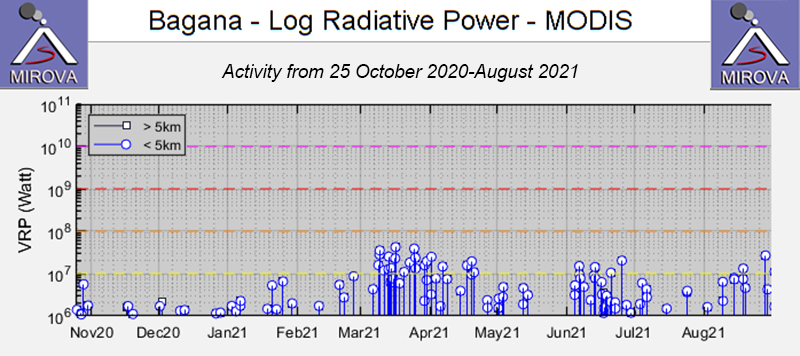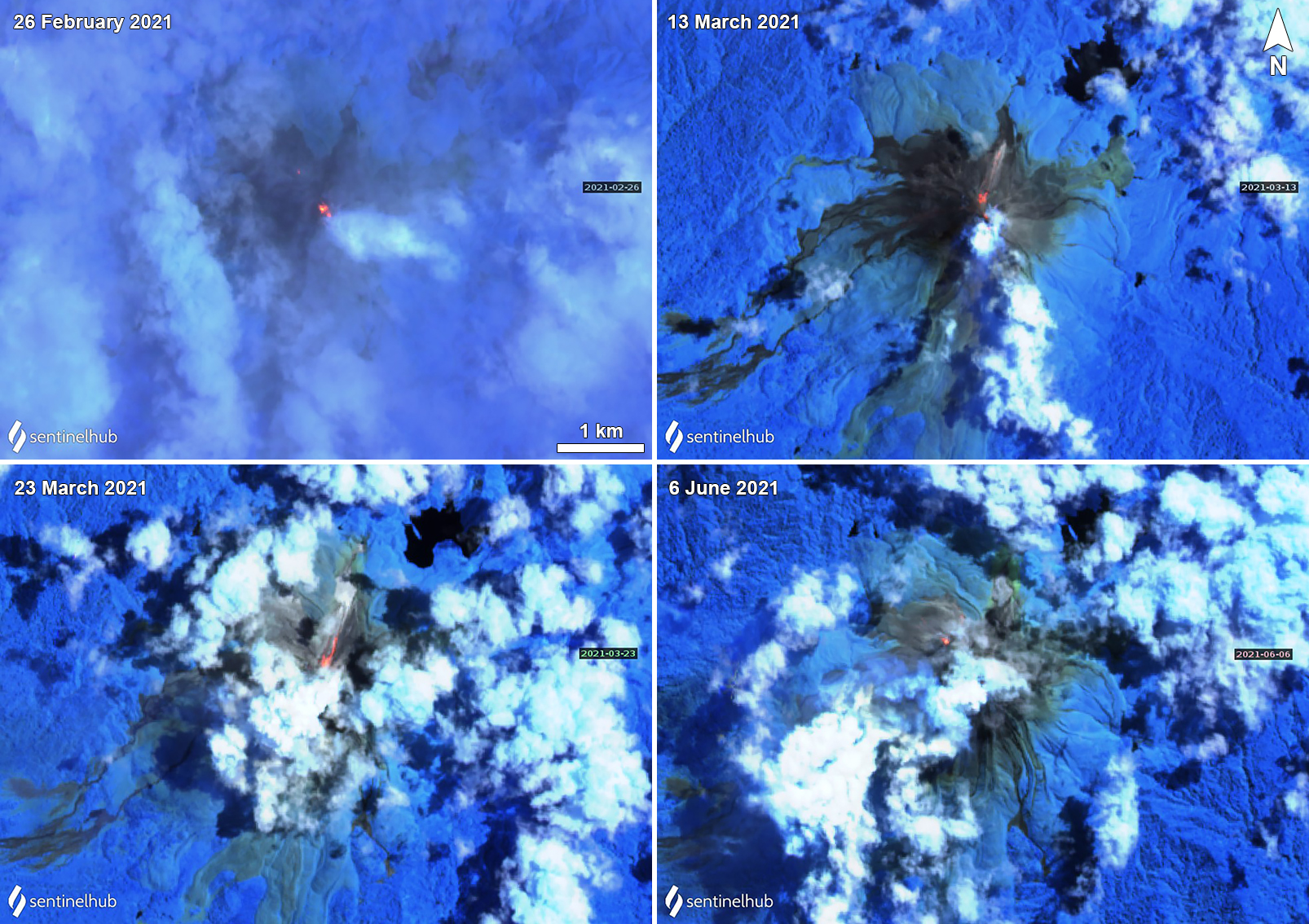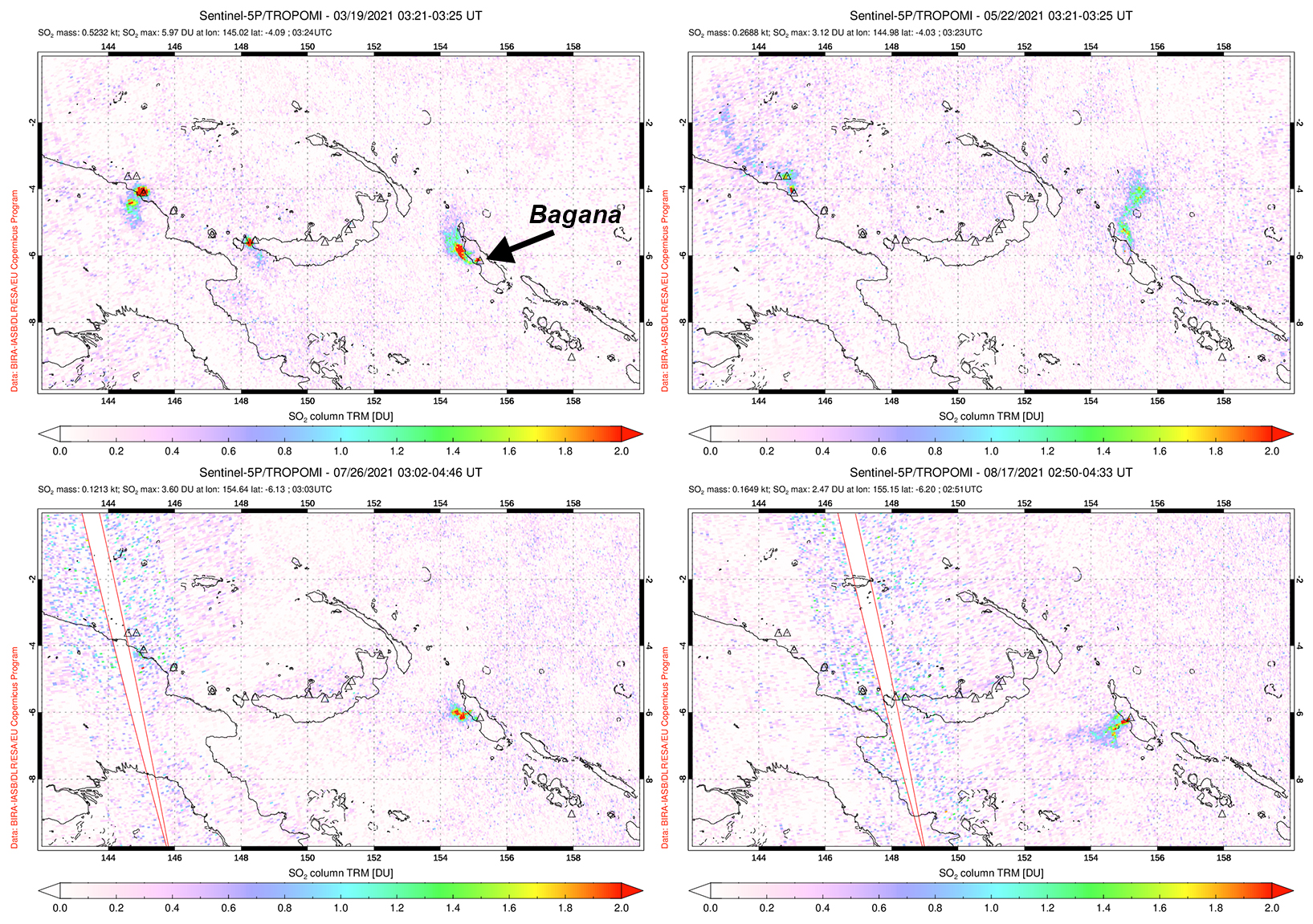Report on Bagana (Papua New Guinea) — September 2021
Bulletin of the Global Volcanism Network, vol. 46, no. 9 (September 2021)
Managing Editor: Edward Venzke.
Edited by Kadie L. Bennis.
Bagana (Papua New Guinea) Intermittent thermal anomalies continue and a possible lava flow during March 2021
Please cite this report as:
Global Volcanism Program, 2021. Report on Bagana (Papua New Guinea) (Bennis, K.L., and Venzke, E., eds.). Bulletin of the Global Volcanism Network, 46:9. Smithsonian Institution. https://doi.org/10.5479/si.GVP.BGVN202109-255020
Bagana
Papua New Guinea
6.137°S, 155.196°E; summit elev. 1855 m
All times are local (unless otherwise noted)
Bagana, located in central Bougainville Island in Papua New Guinea, is a remote volcano that has had historical eruptions dating back to 1842. The current eruption period began in February 2000 and has more recently consisted of ongoing thermal anomalies, possible lava flows, and gas-and-steam emissions (BGVN 46:01). This report updates information from January through August 2021 and describes continuing thermal anomalies, lava flows, ash emissions, and sulfur dioxide emissions using information from the Darwin Volcanic Ash Advisory Center (VAAC) and various satellite data.
MIROVA (Middle InfraRed Observation of Volcanic Activity) analysis of MODIS satellite data showed intermittent low-power thermal anomalies during January through August (figure 38). During late February the power of the thermal anomalies gradually increased and remained high during most of March due to possible lava flows that were present near the summit crater. This activity gradually decreased in power during April and remained low until early June, though these anomalies were still lower in power compared to those in March. The intensity of the thermal anomalies gradually increased throughout August. According to the MODVOLC thermal algorithm, a total of eight thermal alerts were detected near the summit area on 9 March (2), 11 March (1), 13 March (1), 16 March (1), 30 March (1), 1 April (1), and 6 June (1) 2021. These thermal alerts, as well as those that were higher in power according to the MIROVA graph, were detected by Sentinel-2 infrared satellite imagery, though cloud cover often prevented a clear view of the summit (figure 39). A strong anomaly was initially detected on 26 February in the summit crater, and by 13 March incandescent material was visible the N flank. Thermal activity suggesting a lava flow extended down the N flank on 23 March. Distinct sulfur dioxide plumes accompanied the stronger thermal anomalies, based on data from the TROPOMI instrument on the Sentinel-5P satellite (figure 40).
Ash emissions reported by the Darwin VAAC on 10 March rose to 2.4 km altitude and drifted NW, based on HIMAWARI-8 satellite images. On 14 June the ash plume rose to 2.1 km altitude and drifted W. Another ash plume on 9 July rose to 1.8 km altitude and drifted W. A Darwin VAAC report issued on 31 July described an ash plume that rose to a maximum altitude of 4.6 km and drifted W, followed by gas-and-steam emissions; however, this was not clearly visible due to the weather.
Geological Summary. Bagana volcano, in a remote portion of central Bougainville Island, is frequently active. This massive symmetrical cone was largely constructed by an accumulation of viscous andesitic lava flows. The entire edifice could have been constructed in about 300 years at its present rate of lava production. Eruptive activity is characterized by non-explosive effusion of viscous lava that maintains a small lava dome in the summit crater, although occasional explosive activity produces pyroclastic flows. Lava flows with tongue-shaped lobes up to 50 m thick and prominent levees descend the flanks on all sides.
Information Contacts: Darwin Volcanic Ash Advisory Centre (VAAC), Bureau of Meteorology, Northern Territory Regional Office, PO Box 40050, Casuarina, NT 0811, Australia (URL: http://www.bom.gov.au/info/vaac/); MIROVA (Middle InfraRed Observation of Volcanic Activity), a collaborative project between the Universities of Turin and Florence (Italy) supported by the Centre for Volcanic Risk of the Italian Civil Protection Department (URL: http://www.mirovaweb.it/); Hawai'i Institute of Geophysics and Planetology (HIGP) - MODVOLC Thermal Alerts System, School of Ocean and Earth Science and Technology (SOEST), Univ. of Hawai'i, 2525 Correa Road, Honolulu, HI 96822, USA (URL: http://modis.higp.hawaii.edu/); NASA Global Sulfur Dioxide Monitoring Page, Atmospheric Chemistry and Dynamics Laboratory, NASA Goddard Space Flight Center (NASA/GSFC), 8800 Greenbelt Road, Goddard, Maryland, USA (URL: https://so2.gsfc.nasa.gov/); Sentinel Hub Playground (URL: https://www.sentinel-hub.com/explore/sentinel-playground).




